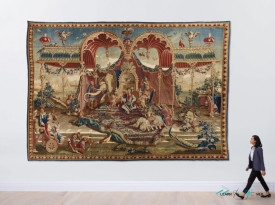
The tapestry depicted in the image is a masterpiece that forms part of the exotic and highly elaborate series, Story of the Emperor of China (Histoire de l'Empereur de la Chine). This series aims to represent the peaceful everyday life of the Qing Manchu Dynasty Emperors, Shunzhi (who reigned from 1644 to 1661) and Kangxi (who reigned from 1662 to 1722), as well as their empresses.
The French East India Company was founded in 1664 as part of the general reorganization of the French economy aimed at strengthening the monarchy. Through this company, the king could acquire the finest oriental luxuries at reasonable prices, while his courtiers competed with each other for costly Asian imports. The founding of this company coincided with the European vogue for chinoiserie. Such was the influx of goods and especially textiles in the 1660s and 1680s, that France in 1686 and later England introduced prohibitions to protect their own industries, although they did not prevent imports and re-exports.
The set's success was undoubtedly due to the increased interest in China at the end of the 17th century. Inspiration for this memorable series perhaps stemmed from the following events at the French court. In 1684, Jesuit missionary Pere Couplet (1623-1693) from Mechelen (Belgium), arrived from China at Louis XIV’s court at Versailles, along with his convert, Michael Alphonsus Shen Fu-Tsung. They were of great interest to the learned and curious scientists and court, fueling the interest of Louis XIV’s young son, the duc du Maine. This resulted in a group of Jesuit mathematicians departing for China in 1685 to establish a French mission, taking with them a letter from the king to the Qing Dynasty emperor, although it was never delivered.
The enthusiasm for the East was further encouraged by Louis XIV's glamorous and exotic reception at Versailles for the ambassadors of Siam (Thailand) in 1686, led by Kosa Pan. The gifts, exotic clothes, good manners, and kowtowing of the visiting embassy caused a sensation. The Beauvais manufactory received visits from both the king and the Siamese delegation in 1686, encouraging director Behagle to initiate exuberant designs to complement the History of the King series of tapestries, undertaken by Charles Le Brun from 1661 to 1668 at the Gobelins manufactory for Louis XIV.
The Story of the Emperor of China tapestry is not only a testament to the exquisite art of French tapestry but also a reflection of the fascinating cultural exchange between East and West during the 17th century. Every meticulously crafted detail in these tapestries transports us to an era of splendor, luxury, and curiosity for the exotic, showing how art can be a bridge between different worlds and times.
Inspiration and Origins, The French East India Company
Many of the images in this series are based on Johan Nieuhof's book, Legatio batavica ad magnum Tartariae chamum sungteium, modernum sinae imperatorem from 1665, which documents the visit of a delegation from the Dutch East India Company to China. As the title Roi de Chine implies, the series was intended to illustrate the Chinese Royal Court. The artists were keen to incorporate as many 'documented' exotic objects as possible in these tapestries.The French East India Company was founded in 1664 as part of the general reorganization of the French economy aimed at strengthening the monarchy. Through this company, the king could acquire the finest oriental luxuries at reasonable prices, while his courtiers competed with each other for costly Asian imports. The founding of this company coincided with the European vogue for chinoiserie. Such was the influx of goods and especially textiles in the 1660s and 1680s, that France in 1686 and later England introduced prohibitions to protect their own industries, although they did not prevent imports and re-exports.
The set's success was undoubtedly due to the increased interest in China at the end of the 17th century. Inspiration for this memorable series perhaps stemmed from the following events at the French court. In 1684, Jesuit missionary Pere Couplet (1623-1693) from Mechelen (Belgium), arrived from China at Louis XIV’s court at Versailles, along with his convert, Michael Alphonsus Shen Fu-Tsung. They were of great interest to the learned and curious scientists and court, fueling the interest of Louis XIV’s young son, the duc du Maine. This resulted in a group of Jesuit mathematicians departing for China in 1685 to establish a French mission, taking with them a letter from the king to the Qing Dynasty emperor, although it was never delivered.
The enthusiasm for the East was further encouraged by Louis XIV's glamorous and exotic reception at Versailles for the ambassadors of Siam (Thailand) in 1686, led by Kosa Pan. The gifts, exotic clothes, good manners, and kowtowing of the visiting embassy caused a sensation. The Beauvais manufactory received visits from both the king and the Siamese delegation in 1686, encouraging director Behagle to initiate exuberant designs to complement the History of the King series of tapestries, undertaken by Charles Le Brun from 1661 to 1668 at the Gobelins manufactory for Louis XIV.
Recent Auction and Provenance
Recently, this tapestry was auctioned at Sotheby's with an estimated price of 150,000 - 250,000 GBP. Previously, it was part of the Rousseau collection and was sold at Galerie Georges Petit in Paris in 1912.The Story of the Emperor of China tapestry is not only a testament to the exquisite art of French tapestry but also a reflection of the fascinating cultural exchange between East and West during the 17th century. Every meticulously crafted detail in these tapestries transports us to an era of splendor, luxury, and curiosity for the exotic, showing how art can be a bridge between different worlds and times.



